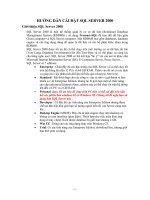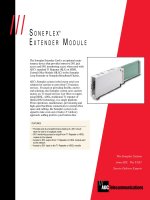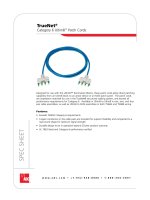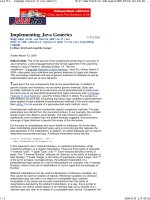Tài liệu SONEPLEX DS1 LOOP EXTENDER MODULE ppt
Bạn đang xem bản rút gọn của tài liệu. Xem và tải ngay bản đầy đủ của tài liệu tại đây (41.73 KB, 2 trang )
The DS1 Loop Extender (DLX) module is used to extend a DS1
up to 655 feet to a digital cross-connect (DSX-1). The DLX
receives a non-return to zero (NRZ) 1.544 Mbps signal from the
DS3 Soneplex multiplexer module, converts the NRZ signal to a
bipolar DS1 signal and transmits a DS1 signal that meets the
industry standard DSX-1 template boundaries as defined by TR-
NWT-000499.
ADC’s Soneplex system is the lowest total cost solution for
carriers to grow their T1 business services. Focused on providing
flexible, end-to-end solutions, the Soneplex system saves carriers
money on T1-based services over fiber or copper, using HDSL,
ADSL, traditional T1 repeater or Optical DS2 technology, in a
single platform. From operations, maintenance, provisioning
and high-speed backbone connections to central office space and
cabling, the Soneplex system is designed to take costs out of
today’s T1 delivery approach, adding profit to your bottom line.
The Soneplex System
from ADC. The T1/E1
Service Delivery Experts
S
ONEPLEX
®
DS1
L
OOP
E
XTENDER
M
ODULE
FEATURES
• Front panel status and alarm information provided via LEDs
• Enhanced performance monitoring and extensive diagnostic functions
• Low power consumption - 2.5 watts
• Meets the industry standard DSX-1 template boundaries as defined by
TR-NWT-000499
• Supports OSS interfaces: TL1, TBOS and craft access
486 2/98 Revision © 1995, 1998 ADC Telecommunications, Inc. All Rights Reserved An Equal Opportunity Employer
Specifications published here are current as of the date of publication of this document. Because we are continuously improving our products,
ADC reserves the right to change specifications without prior notice. At any time, you may verify product specifications by contacting our
headquarters office in Minneapolis. ADC Telecommunications, Inc. views its patent portfolio as an important corporate asset and vigorously
enforces its patents. Products or features contained herein may be covered by one or more U.S. or foreign patents.
ADC Telecommunications, Inc.
P.O. Box 1101
Minneapolis, Minnesota 55440-1101
FAX: (612) 946-3292
From North America, Call Toll Free: 1-800-366-3891, Ext 3223
Outside of North America: 612-938-8080
Home Page Address:
International Sales Offices: Belgium 32-2-712-6500 • United Kingdom 44-734-441955
• Montreal, Quebec (514) 677-9166 • Vancouver, BC (604) 270-1675 • Toronto, Ont.
(905) 629-3104 • Ottawa, Ont. (613) 723-2171 • Singapore 65-225-8228 •Venezuela 58-
2-286-1444 • Mexico City, Mexico 525-658-4519 • Buenos Aires, Argentina (541) 449-
2669 • Sao Paulo, Brasil 55-11-3040-0666 • Sydney, Australia 61-2-9975-1499 •
Melbourne, Australia 61-3-9585-3931 • Beijing, China 86-10-6500-7001 • Dusseldorf,
Germany 49-211-530-6550 • Seoul, Korea 82-2-333-8989
Soneplex
®
DS1 Loop Extender Module
Description
Dimensions (HxWxD):
Weight:
Operating Temperature:
Operating Humidity:
DS1 Line Rate:
DS1 Line Codes:
DS1 Distance:
DS1 Transmit Distance:
DS1 Repeater Interface:
Input Power:
Maximum Input Current:
Power Consumption:
4.4" x 0.7" x 9.2" (11.76 x 1.78 x 23.37 cm)
0.06 lbs (.27 kg)
-40°F to 149°F (-40°C to 65°C)
5% to 95%, non-condensing
1.544 Mbps ± 200 bps
AMI or B8ZS
up to 655' with output signal equalizer setting
DSX-1 template per TR-NWT-000499
3 dB to -10 dB
-42.5 to -56.5 VDC
90 mA at -42.5 VDC nominal
2.5 watts nominal
Soneplex
DS1 Loop Extender Module
Description
Catalog Number
SPX-DLX0A1
Ordering
Information
CENTRAL OFFICE
Up to 655'
DS3
DLC
Channel Bank,
Smart Jack
SONEPLEX
DLX
D
S
X
D
S
X
CORE
NETWORK
The DS1 Loop Extender provides a DS1 signal interface to additional network elements
(digital loop carriers, channel banks, etc.). When fully configured, a Soneplex Broadband
chassis will support up to 28 DLX modules. The network DSX interface is a bidirectional,
industry standard DS1 interface for use with cable lengths up to 655 feet. The DLX unit
continuously monitors the performance of the DS1 from the customer location for loss of
signal (LOS), bipolar violations (BPVs) and bit error ratio (BER). The DLX collects the DS1
performance information and then reports it to the main processor unit, which in turn
provides the interface to an operation support system (OSS).
Specifications









